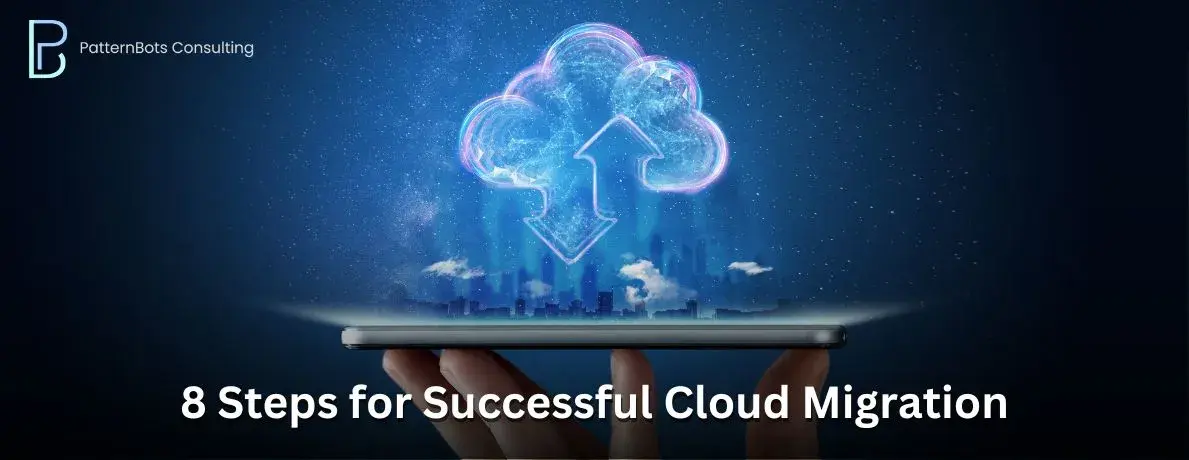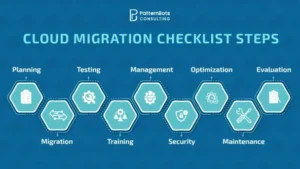
In the modern world, companies of all sizes realize the numerous advantages of moving to the cloud. The benefits are multiple—from flexibility and scalability to better collaboration and reduced costs. However, developing a cloud migration strategy is not easy, requiring extensive planning and implementation.
But First,
What is Cloud Migration?

Cloud migration involves transferring data, applications, and other organizational resources from a physical infrastructure to a cloud infrastructure. This shift enables businesses to harness the benefits of the cloud, which is capable, virtually limitless, and on-demand.
The cloud migration strategy involves moving different components of your IT environment, such as servers, databases, applications, and files, to your cloud provider’s servers. This transition allows companies to decrease their dependency on physical infrastructure, optimize processes, and leverage the scalability and flexibility of cloud services.
Cloud migration is a business decision that helps organizations leverage the power of the cloud.
What are the Advantages of Relocating to the Cloud?

Here are some advantages that force associations to move assets to the cloud.
Scalability
Distributed computing can scale to help bigger jobs and clients considerably more effectively than on-premises frameworks. In customary IT conditions, organizations needed to buy and set up actual servers, programming licenses, stockpiling, and organization gear to increase business services.
Cost
Cloud suppliers offer oversaw administrations that bring down your functional above and work on support errands like updates. Organizations relocating to the cloud can spend fundamentally less on IT tasks. They can dedicate more assets to advancement — growing new items or working on existing products.
Performance
It is important to move to the cloud to develop execution and client experience. A cloud-based application or site can be scaled to serve more clients or have a higher throughput if hosted on the cloud.
Digital experience
Clients can access cloud administrations and information from anywhere, whether workers or clients. This empowers a better client experience and provides cloud representatives with current, adaptable tools.
Cloud Migration Checklist Steps

Step 1. Cloud Migration Planning
It is essential to start with planning; with most strategies, planning is among the first steps. This may involve developing a schedule for the migration operation, resources that should be used, and methodologies to use. This roadmap also describes in which step applications and data are used to perform the migration and in which priority those apps and data are essential to your business processes.
Step 2. Cloud Migration Design
The following phase of the cloud migration process is implementing or architecting the cloud environment. This entails
- Selecting the right cloud services
- Configuring network settings
- Establishing security measures
It involves deciding where the data will be stored, how to access the data, and the backup system that will need to be adopted for the identified assets.
Step 3. Migration
After the design phase, the cloud migration provider moves through the data migration phase. It is important during this process to isolate the proper migration technique, which can be either a one-phase or a two-phase migration, depending on the volume of data to be migrated and the connectivity available on the network.
Step 4. Cloud Migration Testing
The next crucial activity is to familiarize oneself with the new environment in the cloud after migrating there. This involves
- Loading
- Security
- User acceptance testing
It is also imperative to check if all the applications are running correctly and efficiently.
Step 5. Cloud Migration Training
On the occasion when the cloud environment has been created and is functional, the next stage is to train all the team members. In this step, they will get a working implementation of the new working environment and study the possibilities for using the outline of the cloud. Therefore, it is necessary to continue working on applying best practices to increase the effectiveness of the work.
Step 6. Cloud Migration Management
Once a new business has shifted its services or products to the cloud, there must be a perfect management process to keep things the same. Those managing it should stay aware to ensure that the expenditure of resources is appropriate and that any contention relative to performance, safeguard, or any other related performance or non-performance distress is resolved. Another advantage is that cloud provisioning management tools can retain control of cloud resources and follow proper policies and governance.
Step 7. Cloud Migration Security
As suggested, security and compliance are best done in an almost never-ending process right from the planning phase—the stage where you decide to move to the cloud. Strong controls for data access, compartmentalization through data encryption, and other features such as user identification and authentication are advised. Conformity to industry standards should also be periodically checked, and verification ensures minimal risks and customer loyalty.
Step 8. Cloud Migration Optimization
Another thing to bear is that it is not necessary to fine-tune the cloud environment once and get optimal performance per the required service level agreement and the cost function in cloud computing. Thus, resource consumption will be regulated, potential shortages and ill-optimized areas will be identified, and required modifications will be implemented. The processes in each application will be automated, and using serverless computing will also help minimize overhead.
Step 9. Cloud Migration Maintenance
A person should ensure that there is an effective way of constantly observing the cloud environment to assess system performance, threats to security, and likely issues. For workload continuity and to ensure that the cloud infrastructure is always safe from external threats, it is advised that a reactive model be adopted for system maintenance, upgrade, patching, and backup.
Step 10. Cloud Migration Evaluation
Finally, it is also essential to evaluate your plan for cloud migration, which can help determine its success. Identifying and comparing the KPIs will also prove useful when carrying out the benchmarking assessment. This will help you ensure that you are always assessing your business objectives to prevent stagnation and find new innovations in the cloud.
With this comprehensive checklist, you can confidently navigate the cloud migration process and maximize the cloud’s benefits. A successful cloud migration process is not a one-time event but an ongoing process that requires constant monitoring, adaptability, and proactive management.
Choose Cloud Migration Company. Think PatternBots!
PatternBots is one of the best cloud migration firms that has been helping businesses streamline their operations and improve their services for a long time. With our forward-looking approach, our team of specialists ensures cloud migration steps match your specific business needs. Our dedicated team provides seamless implementation, optimization, and support, placing your business goals at the core of their services – Trust PatternBots for exceptional results and a truly seamless cloud migration experience that elevates your business to new heights.
Frequently asked questions
What is the cost of cloud migration?
The cost of cloud migration depends on the service provider’s choice. Some of the most popular cloud migration service providers are AWS, Azure, and Google Cloud. The cost of cloud migration can be determined based on various factors, primarily your current requirements.
What cloud service platforms can I look at?
AWS service for migration is suitable if you are looking for a wide array of options. Microsoft Azure if your organization runs on Microsoft and Windows. Google Cloud Platform if you are experimenting with AI/ML. These are suggestions, as we can help you with cloud migration by following these cloud migration checklists to ensure a successful process.